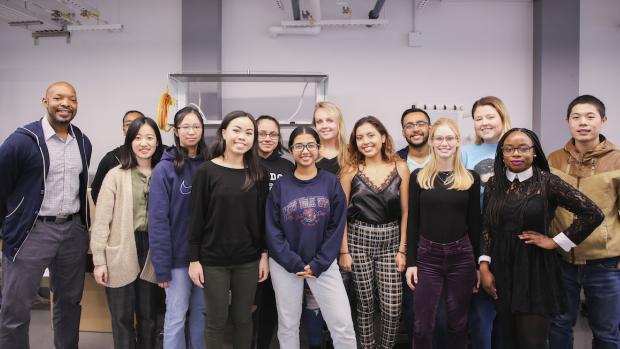A dozen CBE students put a new spin on gender balance in the lab

Professor André Taylor, his teaching assistant, and his lab students.
This semester, if you happen to peer into André Taylor’s lab on any given Tuesday afternoon, something might strike you as decidedly different. It’s just as bustling as any senior chemical engineering lab, with students conferring around the workbenches and busily prepping experiments using the continuous stirred tank reactor, heat exchanger, or flow control system. Still, it presents an unusual sight: of the dozen students in Taylor’s lab, 11 are women. “I didn’t plan it this way,” he explains. “It just happened during registration for this section, but it does seem notable.”
Taylor’s class composition speaks, in part, to the fact that in general, chemical engineering attracts a somewhat higher proportion of women. The American Society of Engineering Education states that while slightly more than one in five engineering bachelor’s degrees are earned by women overall, the figure leaps to about one in three for chemical engineering bachelor’s degrees.
It is also deeply reflective of the fact that NYU Tandon is enrolling increasing numbers of women in every department throughout the school: almost 60% of the Department of Chemical and Biomolecular Engineering (CBE) is now comprised of women students.
Taylor’s students, who hail from a wide variety of backgrounds and from as far away as Brazil and Zimbabwe, present several reasons for being attracted to the major. Several loved biology in high school and were attracted to the commonalities in the fields; others saw it as an interesting pathway to medical school. Nichelle Campbell, a senior who plans to forge a career with the MTA, says, “CBE is very versatile; there’s really no limit what you can do with this skill set. The important thing is that any path you choose, from medicine to environmental design, can enable you to make a difference.” (One student, Emily Pennell, is providing irrefutable proof of that versatility — and of the potential of chemical engineers to bring enjoyment to the world; she has already accepted a job at Moto Spirits, a Brooklyn-based distillery. “Distilling is basically chemistry,” she explains.) Some, including Zijing Zhang and Amy Wood, foresee following in Taylor’s footsteps and going on to earn graduate degrees, thus becoming part of a proportionately smaller subset of female doctoral candidates in chemical engineering. (Zhang has been accepted to the University of Pennsylvania, while Wood will be attending Georgia Tech.)
Many students point to the fact that word of mouth has been spreading about Taylor’s patient and helpful teaching style, making his classes popular ones. That is not to say that anyone would ever consider slacking or doing less than their best. “This is a really bright, quick-thinking group,” Sandesh Bhattarai, the sole man in the class, asserts. “I’m always surprised when anyone asks me what it’s like to be in a group with so many women; mainly I just think of this as a class with a lot of smart, ambitious chemical engineers.”
In 2005, the Caltech 6, then the first and only all-female chemical engineering class to graduate from any coed U.S. college, made headlines. Now, in 2019, the Tandon 11 are making a splash right here in Brooklyn.




